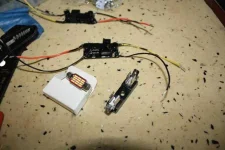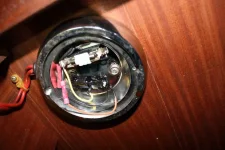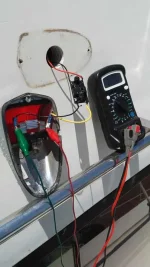barkdee
Active member
- Joined
- Jul 16, 2014
- Messages
- 64
- Status
- OWNER - I own a Hatteras Yacht
- Hatteras Model
- 50' CONV -Series II (1979 - 1983)
Here's how I've converted my 32 volt lighting to use 12 volt LEDs. Takes a bit of work but the cost is low, $2.50 plus the bulb cost. So far, after six months, the lights are working fine -no bulb burnout or converter failures. But, the parts are low cost Chinese Ebay stuff so, disclaimer, don't do what I do, and if you try this monitor everything regularly and make sure it's not overheating or drawing too much current.
I've used these low voltage DC buc converters to convert the 32v at the light socket to 12v.
http://www.ebay.com/itm/10pcs-LM259...e=STRK:MEBIDX:IT&_trksid=p2060353.m2749.l2649
And these festoon LED bulb sockets
http://www.ebay.com/itm/36mm-31mm-S...e=STRK:MEBIDX:IT&_trksid=p2060353.m2749.l2649
With these LEDs for closet lights
http://www.ebay.com/itm/10PCS-31mm-...e=STRK:MEBIDX:IT&_trksid=p2060353.m2749.l2649
And these LEDs for running lights
http://www.ebay.com/itm/4pcs-36mm-1...e=STRK:MEBIDX:IT&_trksid=p2060353.m2749.l2649
The process is:
1. solder three to four inch leads on the buc converters.
2. connect a multi meter to Vout of the converter -use alligator clips
3. Use alligator clips and connect Vin + and - to 32v. Watch the polarity. If you connect the converters backwards you will fry them. They'll spark and a surface mount resistor on them will explode. No fire, just a little smoke and a 'pop.'
4. Use a very small screw driver, turn the converter's trim pot until you get 12 volts on the output. Takes five or ten turns.
5. Turn off the power, disconnect the alligator clips and coat the converters with two coats of liquid electrical tape to pot them and give them some protection from salt air.
The converters can now be crimp wired into the 32v socket wiring and spade connected to the festoon sockets. Below are pics of them wired up. They fit ok in the closet sockets and fit just right in the running lights. I wouldn't use them as running lights but I don't run much at night and I carry battery powered red/green running lights just in case they fail while underway.
I've used one converter per LED light -drawing 200 or 300 milliamps. The converters are rated to supply something like five times this but I wouldn't go there. Heat sinks would be needed and the converters could be expected to fail much sooner.
When wiring up the converters, pay close attention to polarities. Check with a multi meter and know before connecting exactly what's plus and minus. And note the bulbs are polarity sensitive without markings telling what is neg and pos. I turn on the lights without a bulb installed then touch a bulb to the socket and verify what direction the bulb goes in. Then turn off the power and install the bulb.



I've used these low voltage DC buc converters to convert the 32v at the light socket to 12v.
http://www.ebay.com/itm/10pcs-LM259...e=STRK:MEBIDX:IT&_trksid=p2060353.m2749.l2649
And these festoon LED bulb sockets
http://www.ebay.com/itm/36mm-31mm-S...e=STRK:MEBIDX:IT&_trksid=p2060353.m2749.l2649
With these LEDs for closet lights
http://www.ebay.com/itm/10PCS-31mm-...e=STRK:MEBIDX:IT&_trksid=p2060353.m2749.l2649
And these LEDs for running lights
http://www.ebay.com/itm/4pcs-36mm-1...e=STRK:MEBIDX:IT&_trksid=p2060353.m2749.l2649
The process is:
1. solder three to four inch leads on the buc converters.
2. connect a multi meter to Vout of the converter -use alligator clips
3. Use alligator clips and connect Vin + and - to 32v. Watch the polarity. If you connect the converters backwards you will fry them. They'll spark and a surface mount resistor on them will explode. No fire, just a little smoke and a 'pop.'
4. Use a very small screw driver, turn the converter's trim pot until you get 12 volts on the output. Takes five or ten turns.
5. Turn off the power, disconnect the alligator clips and coat the converters with two coats of liquid electrical tape to pot them and give them some protection from salt air.
The converters can now be crimp wired into the 32v socket wiring and spade connected to the festoon sockets. Below are pics of them wired up. They fit ok in the closet sockets and fit just right in the running lights. I wouldn't use them as running lights but I don't run much at night and I carry battery powered red/green running lights just in case they fail while underway.
I've used one converter per LED light -drawing 200 or 300 milliamps. The converters are rated to supply something like five times this but I wouldn't go there. Heat sinks would be needed and the converters could be expected to fail much sooner.
When wiring up the converters, pay close attention to polarities. Check with a multi meter and know before connecting exactly what's plus and minus. And note the bulbs are polarity sensitive without markings telling what is neg and pos. I turn on the lights without a bulb installed then touch a bulb to the socket and verify what direction the bulb goes in. Then turn off the power and install the bulb.




